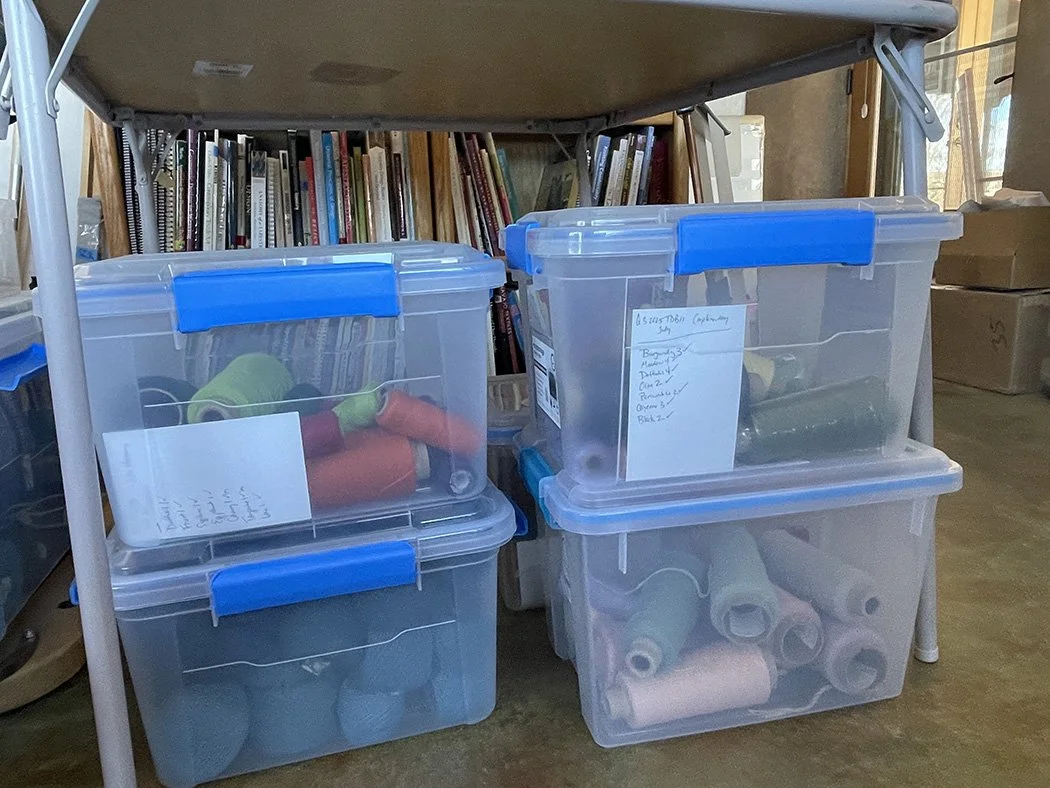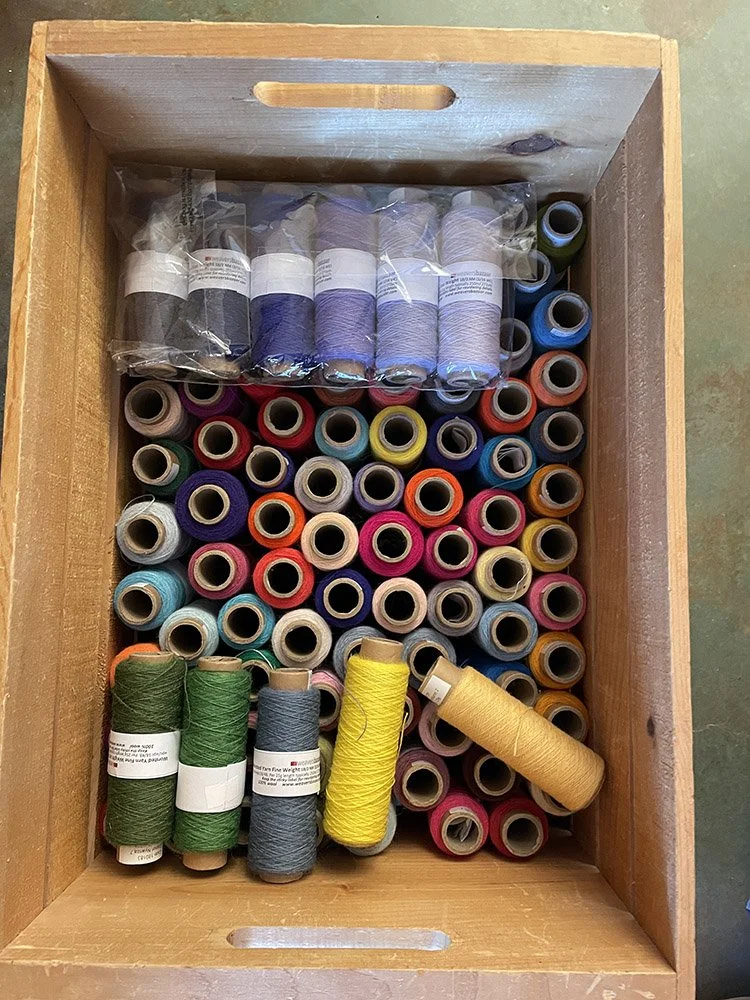I moved to this new home and studio almost a year and a half ago now and I’ve had many requests from followers and students for some tips on studio organization. I definitely understand the hope that someone will have just the answer that will make me feel like I know where everything is and it is easy to use.
I’m pretty sure I’m not the person to give you this advice. I wanted to be the efficient tapestry weaver who has her systems all pulled together, but I finally realized that though I might have some tips for certain situations, I’m not a person who is rigorously organized. Many days I’m not even loosely organized especially when it comes to materials. It is a common thing for me to spend a lot of time searching for a tool I need and can’t find. It leads to having tool duplicates for sure!
I’ll show you some of the ways I keep myself from completely self-destructing as I work, but I am the person who loves to see all my materials spread out at all times. And I don’t have space for that. So I’ve had to come up with some tricks and mostly those involve containers.
Yarn management
Since moving to this studio, I’ve had to sit myself down and give myself a little talking to. My friend and colleague, Jillian Moreno, started using plastic gasket boxes for her fiber supply and I decided it was a smart move. I started purchasing these a couple years ago as I began packing to move. I now have most of my yarn and spinning fiber stash stored in these bins. They come in various sizes and they have a rubber gasket around the edge of the lid with strong clips that hold the lid down. They’re supposed to be water-tight though I don’t have a boat to throw one over the side of to test it.* I figure if they’re water tight, moths can’t get into them.
So starting from my wish not to have my fiber supply infested with moths,** I decided to use those clear tubs as an organizing principle. In my former studios in Santa Fe and Fort Collins, I had open shelves upon which I organized the yarns by color. Though I find that very convenient to tell what I have at a glance, it invites pests. In this new studio, I have a lot of windows and almost no room for shelves. So the yarn lives in my yarn attic.*** When moving I just shoved the yarn into bins usually with tools and breakables packed within, some of which I’m still finding in my knitting yarn supply. Many months after we moved, I spent several days going through and sorting the yarn. Tapestry yarn is sorted by type and then by color if there is more than one bin’s worth of a type of yarn.
75 L gasket bins used to store tapestry yarn
For example, I have the most of my hand-dyed Harrisville Koehler Singles yarn which I use for my larger tapestries. I have many 75 liter tubs of this yarn and I sorted it first by projects and then by color. So if I had a project dyed that hasn’t been woven yet, those yarns all go together. The large bin pictured here is one such example. This is a huge batch of yarn I dyed for a series of work in blues through violets and they all stay together in several bins. If you’re following me on Patreon, this is the yarn for the current series of work I’m showing you there. I have three huge bins of this yarn so it should be enough for the three large planned tapestries.
I’ve used the clear plastic pockets that shippers use on the outside of packages to hold the labels called packing list envelopes. The envelopes are sticky along the back. I stick them on the bin and then I can put a 5 x 7 index card in the pocket to indicate what is in the bin. This helps me locate the yarn I need much more quickly. This was not my idea! It was possibly Jillian’s, but I honestly can’t remember where I learned this. It works great.
A future project might be to inventory the yarn. It would be nice to at least have a list of what tapestry yarns I have and how much of it even if I don’t have all the colors noted. Once I start a project, the yarn for that project is on a table by the loom.
Smaller projects
Examples of open-topped bins used to keep projects separated.
I always have many projects going at once. Many of them are for teaching. Most of these are fairly small weavings on smaller looms which just sit in the corners of my studio until I’m ready to shoot whatever class they’re for. I’ve started using open topped bins for the materials for these projects and I slip a 5 x7 index card in the bin with the yarn names and details I need to remember on it. Any tools I need to continue to use to shoot video are also included in the bins so it hopefully all stays together. The image here has a spinning project in the front bin and some materials for an online class in the back bin.
I have also started using small gasket tubs for the Tapestry Discovery Box in particular. The yarns for these boxes are chosen 6 to 12 months ahead of time and I need to make sure that I keep the set of yarn together until those projects are woven. These are fairly immediate projects and these boxes are under the table in my studio that has the yarn for my current large-loom weaving.
Smaller gasket tubs for classes I’m teaching online. The index cards indicate the project (Tapestry Discovery Box for the two at the top) along with the colors in that box.
Books
One of many bookshelves in my world
There are four bookshelves in my studio and they are stuffed with books. One shelf is for knitting books and piano music and the other three are tapestry and art books. These books are regularly consulted and I can’t imagine putting them anywhere else.
Other organization tips
I have bags and bins and cups full of tools and pens and art supplies scattered around my studio. I can’t give you tips on those because I have yet to figure out a way to reign all that in. What I do make sure of is that the handful of tools and art supplies I use the most are always returned to the same place. That works fairly well (until it doesn’t).
On my Harrisville Rug Loom, I have hung a tool bag which is actually meant to hang on the back of a Mirrix loom. Because I don’t have a shelf or table right next to the loom, this bag works really well for storing my scissors, notes, tapestry fork, and thread for sewing slits.
Tool bag on the overhead beater on my loom.
Tool bag made for a Mirrix loom on my HD rug loom. This bag is made by CGN Brass Ring Design on Etsy.
Other yarns that I tend to access quite a bit are in various containers on the main floor of my studio. This is some of my weaversbazaar collection. This would also work for the tubes of Gist Array. I keep my Array yarn in two larger tubs because I have a lot of the 4 ounce cones as well as the tubes.
I’ve seen people rig up all sorts of ways of hanging these tubes. A spool rack works well or you can make a spool rack with dowels hung from something
The final disorganized word
I do my best, but I definitely feel like there are others out there with much better organizational tendencies for their tools and materials. I continue to think if I just had a bigger studio or if I just had one of those dental cabinets with all the little drawers, or if… But the truth is, none of it would change my basic nature. I love tools and materials and I love a bit of a creative mess. And that often means that I can’t find what I need which, though frustrating, is just the way it is.
Happy weaving!
*These bins are actually quite hard to find. I was getting them at Target for awhile but mostly I can’t find them any more. The ones at Home Depot you can’t see through and that just won’t work for me. No one will ship them. So I’ve taken to haunting the Target and Lowe’s in Farmington, NM on the infrequent occasions we go there just in case some of these show up.
**I’ve learned quite a bit about moths since my one run-in with them in 2013. Besides storing all fiber in gasket tubs and liberally filling them with cedar blocks and lavender sachets just to be sure, I use moth traps to know whether I have a problem and I’ve added a deep freeze to our garage. If ever I purchase questionable yarn or any protein fiber of any kind at a thrift shop, it will not come into my house before a few cycles in the deep freeze. Moths are no joke.
**I am so thrilled with my yarn attic! It is a smallish attic space that is completely sealed and finished with drywall and accessible from a pull-down ladder in the closet in the studio. It is a magic fiber treasure trove. And yes, there are moth traps up there too. (Moth traps don’t fix the problem! They just tell you you HAVE a problem. They’re the canary in the coal mine.)



